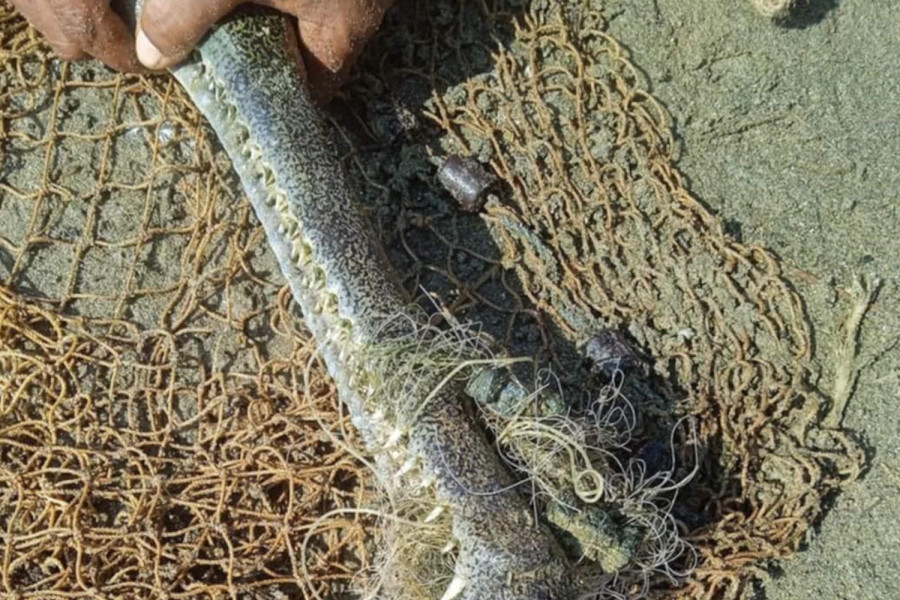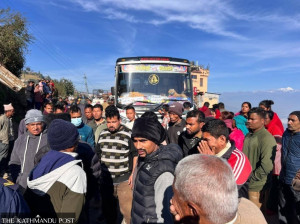Bagmati Province
Fishing nets pose a grave threat to gharials in Chitwan
Park officials battle to protect this critically endangered species from human threats.
Ramesh Kumar Paudel
The conservation of Chitwan’s gharial, a critically endangered species of crocodile, has of late been quite challenging. Conservationists say amid multiple challenges, the most worrying are human activities, river pollution, and the depletion of fish in rivers and streams.
Of late, fishing nets placed in rivers and streams have become a major threat to gharials in the Chitwan National Park (CNP), the country’s first national park. Although the park administration banned the use of such nets in its waters, their use continues unchecked, posing serious risks to gharial conservation.
On October 28, a CNP team rescued a gharial trapped in a fishing net in the Rapti, a river that runs through the Chitwan National Park. The rescuers and conservationists were elated as they could safely rescue the trapped gharial.
According to Abinash Thapa Magar, information officer at the CNP, the female gharial was caught in the fishing net near Meghauli. “The use of fishing nets has been a major problem. Fishermen illegally install big fishing nets to catch fish which pose a serious threat to gharials and other aquatic life,” said Thapa Magar. He expressed his happiness as the CNP team was able to promptly rescue the trapped gharial alive.
The use of fishing nets is unlawful. The CNP authority allows the Bote community, who eke out a living by fishing, to use hand-fishing nets, but bans the installation and use of large nets in water bodies. Nevertheless, some fishermen defy the CNP’s rules and set fishing nets in the Rapti river and other water bodies within the national park area.
The gharial (Gavialis gangeticus) has been listed as a protected species in Nepal. As per the existing legal provisions in the country, anyone found poaching this animal faces a jail between one to 10 years or a fine ranging from Rs 100,000 to Rs 500,000, or both.
According to conservationists, the endangered gharials are often trapped in fishing nets and die in CNP rivers and rivulets, mostly in the Rapti. To tackle this, Chitwan National Park has banned the use of fishing nets in the river. While conservationists find some consolation in the ban, they say it’s not nearly enough to increase the population of this imperiled species.
According to Thapa Magar, CNP patrol teams detained three fishermen over the past three weeks for illegally using large fishing nets. He claimed that the national park had been working effectively to control the use of such fishing nets and to protect gharials and other animals.
According to the Chitwan National Park, a total of 265 gharials—152 in the Rapti river and 113 in the Narayani river—were counted during the latest census held a year ago. Two gharials were found dead in the national park while one was rescued safely last year.
The authorities conducted a nationwide monitoring in 2016 and recorded a total of 198 gharials. Eighty-four gharials were found in the Narayani river, 82 in the Rapti, 31 in the Babai, and one in the Karnali river.
With an objective of conserving the gharial by hatching its eggs and releasing the young in the rivers once they grow to two metres in length, the Chitwan National Park established a gharial breeding centre at Kasara in 1978. The centre has seen some success. There were just 80 gharials in the country before the breeding centre was established.
The last century has been cataclysmic for the gharials of the world. The gharial population, which was estimated to be between 5,000 and 10,000 worldwide during the 1940s, had dwindled by almost 96 percent to below 200 in 1976.
This species—the only surviving member of the Gavialidae family—breeds only in the wild in Nepal, India, Bangladesh, Bhutan, Myanmar and Pakistan, but is virtually extinct outside Nepal and India. The current global gharial population is estimated to be around 300–900.




 9.12°C Kathmandu
9.12°C Kathmandu1.jpg)











